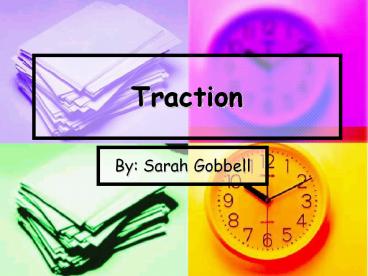Traction - PowerPoint PPT Presentation
Title:
Traction
Description:
Traction By: Sarah Gobbell Traction is the process of putting an extremity, bone, or group of muscles under tension by means of weights and pulleys (pulling force) to ... – PowerPoint PPT presentation
Number of Views:1766
Avg rating:3.0/5.0
Title: Traction
1
Traction
- By Sarah Gobbell
2
What is Traction?
- Traction is the process of putting an extremity,
bone, or group of muscles under tension by means
of weights and pulleys (pulling force) to treat
muscle and skeletal disorders.
3
Purpose
- Traction is used to treat
- Fractures
- Dislocations
- Long-duration muscle spasms
- Prevent or correct deformities
4
Divisions of Traction
- Skin traction
- Skeletal traction
- Short-term (accident scene)
- Long-term ( hospital setting)
5
Skin Traction
- Used for temporary treatment if a light or
continuous force is needed. - Five to seven pound weights are attached to the
skin through adhesive or non-adhesive tape, with
straps, boots, or cuffs. - Allow good circulation to the part of the limb
beyond the point where traction is applied.
6
Skin Traction Dunlops Traction
Dunlops skin traction is applied to children
with certain upper arm fractures that need to
remain in a flexed position to prevent problems
with circulation and nerves around the elbow.
7
Skin Traction Pelvic Traction
- Pelvic Traction is applied to the lower spine
with a belt around the waist
8
Skin Traction Bucks Skin Traction
- Bucks skin traction is used to treat knee
injuries other than fractures. This kind of
traction is used to stabilize the knee and reduce
muscle spasms.
9
Skin Traction Russells Traction
- Russells traction is very similar to Bucks, but
instead they use a sling to allow more movement
in bed and allows flexion of the knee joint.
10
Skin Traction Bryants Traction
- Bryants traction is used for children with
fractured femurs. Both legs are suspended at 90
degree angles to the trunk of the body and the
weight of the body pulls the bone fragments of
the fractured leg into alignment.
11
Skeletal Traction
- Used when more pulling force is needed.
- Uses weights of 25-40 lbs.
- Requires placement of tongs, pins, or screws into
the bone so that the weight is applied directly
to the bone. - This is an invasive procedure done in an
operating room. - Done under local, general, regional anesthesia.
12
Skeletal Traction Cont'd
- The pins may be in place for several months and
must be kept clean to prevent infection. - Pulleys and weights are attached to wires to
provide the proper pull and alignment of the
affected part.
13
Skeletal Traction Halo
- Halo traction is used for cervical fractures and
can also be used to help correct deformities such
as kyphosis as seen on the upper right.
14
Skeletal Traction Halo Contd
- This pictures shows the effects of the halo
traction, before (left) and after (right)
15
Skeletal Traction Tibia Pin
- Used for some fractures of the femur, hip, or
pelvis
Pins are surgically inserted into the femur and
weights are then applied in order to correct the
problem
16
Pre-Op
- X-rays are done pre-op and may be repeated during
treatment to assure a stable alignment - Blood and urine tests are done
- Pt may meet with an anesthesiologist to discuss
health conditions (if skeletal traction is being
done)
17
Post-Op
Skin Traction
- Make sure the limb stays aligned.
- Make sure skin does not become sore or irritated.
- Be sure pt is alert to any swelling or tingling
due to the limb being wrapped too tightly.
18
Post-Op
Skeletal Traction
- Traction may be continued for several months
until healing is complete. - Deep breathing exercises are taught.
- Range-of-motion done to unaffected parts of the
body. - Pt teaching is done on how to use a trapeze bar.
19
Risks
- Two main risks are traction is applied
incorrectly or the skin becomes irritated. - Bone inflammation may occur.
- Infection may occur at the pin sites.
- Because of long periods of immobility, the pt may
develop bed sores, reduced respiratory function,
urinary or circulatory problems. - Traction can take an emotional toll on the pt.
20
THE END































